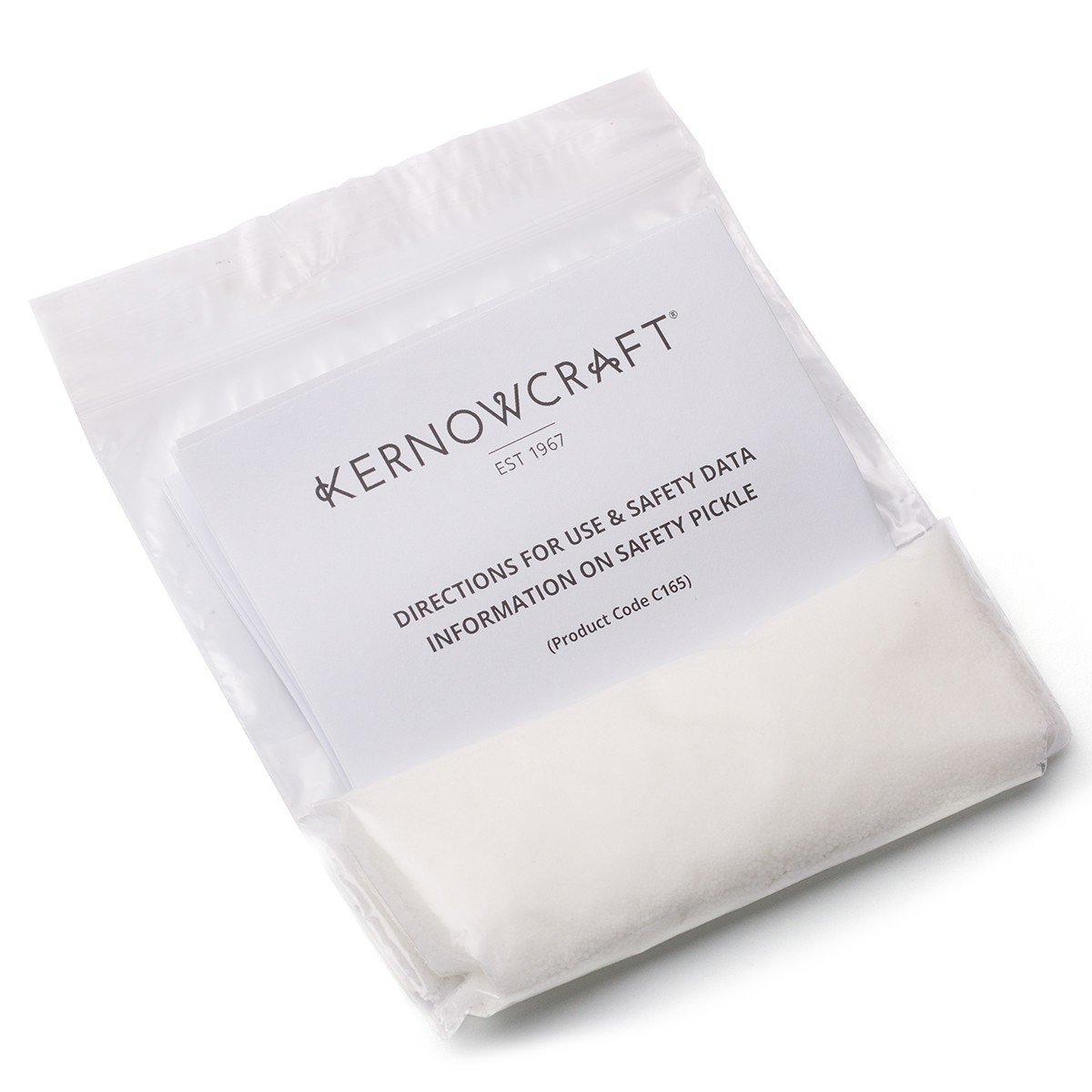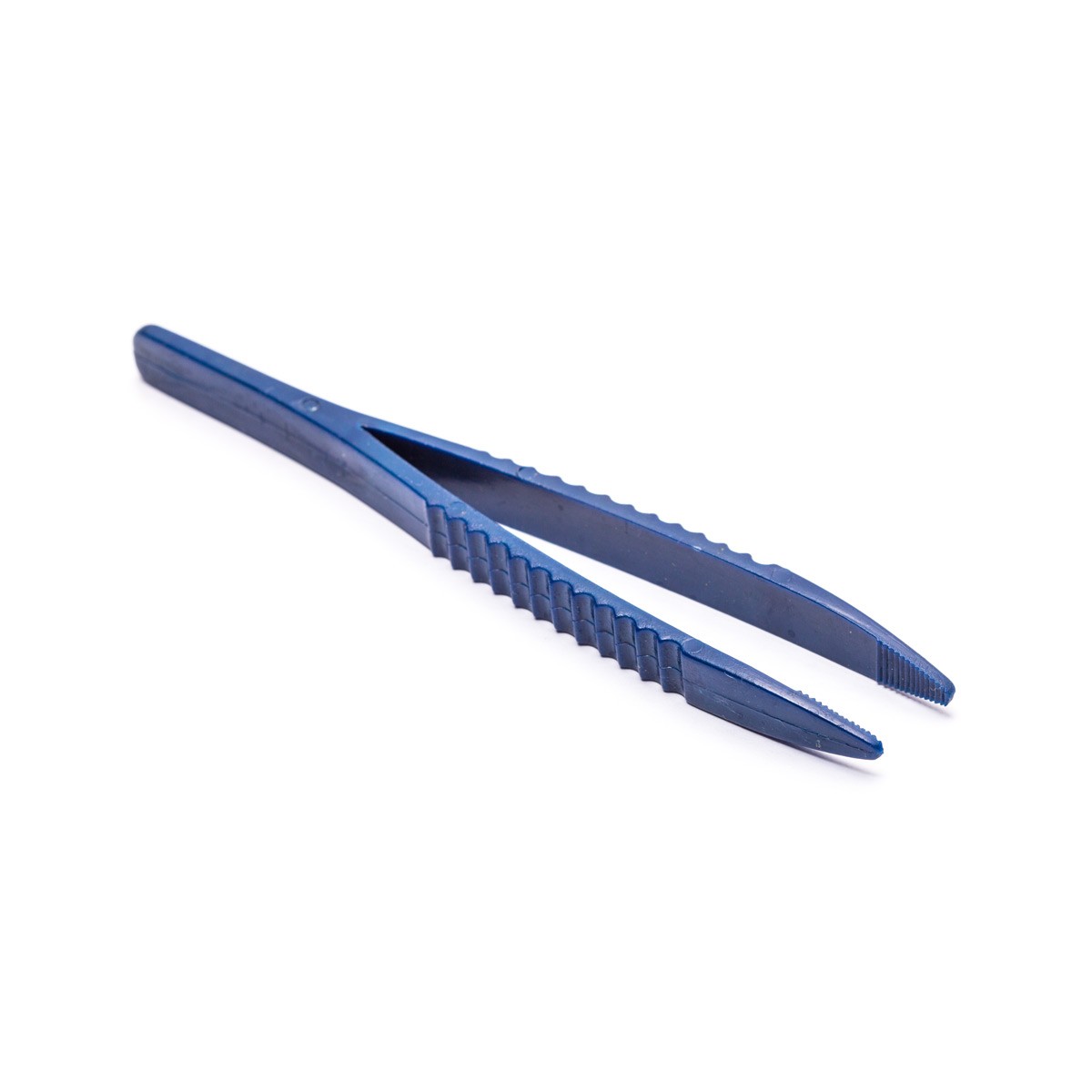How To Use Safety Pickle & The Importance Of Using Plastic Tweezers
What is safety pickle?
The safety pickle we stock at Kernowcraft has been formulated for the removal of oxides from the surface of precious metal components after casting, soldering, annealing and any other processes involving heat. It is an ideal alternative to the dangerous acids normally used and an essential product for every jewellery workshop. When sterling silver is heated impurities can rise to the surface (especially on larger or flatter pieces) and cause a subtle dark shadow. Sometimes this is obvious straight away but sometimes the staining frustratingly surfaces during polishing. Safety pickle is perfect for removing the fire-stain caused by heat during soldering. This special dry acid concentrate is safe to store and easy to use.
On this page, we give instructions on how to use safety pickle as well as the important information you need to know.
This importance of using plastic tweezers
Always use plastic, brass or copper tweezers when inserting or removing items from a pickle bath.
Steel can contaminate the solution, causing a chemical reaction that can copper plate your sterling silver or gold. If you have ever done this you will know just how annoying it can be to find your lovely piece of jewellery with a red tinge which can be hard to polish off.
Also, make sure all binding wire is removed as this will have the same reaction.
SAFETY PICKLE DIRECTIONS FOR USE
Step 1
Heat 1 litre of tap water to approximately 50°C (122°F) in a container capable of resisting acids and caustic solutions (a chemical or polypropylene container is recommended, although glass, most glazed china and most plastics are fine). Many Kernowcraft customers use a slow cooker as their pickle bath which is great as it keeps the pickle warm and is protected with a lid. If you're going to do this, ensure there is no metal inside of the cooker which could contaminate the pickle.
Step 2
Add approximately 50g of the granules to the water (always add pickle to water, not water to pickle) and stir with a wooden spoon or spatula.
To mix a smaller amount, use 250ml of water (approximately 1 cup) and add 12.5g of crystals (approximately 2 level teaspoons).
Step 3
Immerse components to be deoxidised in the solution, which should be maintained at 50°C if possible (the heat speeds up the process but is not entirely necessary) and removed once all the oxides and flux residue is gone, your pieces would also be fine to leave overnight. Once it's ready to take out, rinse with water.
You can use your safety pickle repeatedly over a number of weeks, depending how often you use it. The solution will start to go blue when it is exhausted and needs renewing. Instead of having to heat your pickle up for use every time you want to use it we have found it works fine when dropping hot pieces into the cold solution.
Always Wear Safety Goggles
Goggles or safety glasses should be worn and any splashes washed off immediately.
IMPORTANT INFORMATION
Identification of material: Safety Pickle: white powder/flakes/spheres with a light sulphur aroma.
Composition: Sodium hydrogen sulphate (a modified salt based predominately on sodium bisulphate). The product is not corrosive if kept dry, but in damp or wet conditions it readily absorbs water, forming an acidic liquid which is mildly corrosive when in contact with skin, eyes or by ingestion or inhalation.
Hazards identification: Inhalation: Mildly corrosive if inhaled. Ingestion: Can be mildly corrosive. Skin Contact: Can be mildly corrosive and cause skin ulceration and dermatitis.. Eye Contact: Can be mildly corrosive and cause corneal necrosis and conjunctivitis.
First-aid measures: Skin Contact: Wash of with soap and water. Eye Contact: Irrigate immediately with lots of plain water and seek medical attention if required. Inhalation: Remove to fresh air. Ingestion: Rinse mouth out and drink plenty of water.
Fire fighting measures: Not considered flammable. Extinguishing media dependant on other constituents of fire. May give off sulphur dioxide fumes so wear breathing apparatus.
Spillage/disposal: No specific precautions required. Sweep up powder and collect in a suitable container.
Handling/storage: No specific precautions required but when handling, wear a protective mask, gloves, goggles and non-absorbent clothing.
Every effort has been made to ensure that the information on this page is reliable but we cannot accept liability for any loss, damage or injury, which may result from its use. Data given in this page is solely for guidance in safe handling and use of its product - it does not form part of any specification.
If you have any queries or concerns not covered here, please do not hesitate to contact us.
More Pages in This Category
- Metalsmithing and Soldering General Advice
- How To Make Granulated Hoop Earrings
- Wax Carving & Granulation Process With Rockpool Jewellery
- Common Soldering Problems & Solutions For Jewellers
- The Essential Jewellery Tools & Supplies For Soldering
- Types Of Tweezers For Jewellery Making & Their Uses
- 10 Jewellery Tools For Supporting Your Work
- Using A Third Hand For Jewellery Making
- Using A Charcoal Block For Jewellery Making
- How To Use A Jewellers Piercing Saw
- How To Use Needle Files For Jewellery Making
- Soldering Flux For Jewellery Making Explained
- How To Use Safety Pickle & The Importance Of Using Plastic Tweezers
- How To Prevent & Remove Fire Scale & Fire Stain
- What Is Thermo-Gel Heat Barrier?
- What Is A Multi Chuck & Essential Accessories For Your Dremel Multi Tool
- How To Use Your Scrap Silver For Jewellery Making
- How To Make Scrap Silver Earstuds
- What Is A Ring Mandrel & How To Use It
- How To Adjust Ring Sizes
- How To Make A Ring Band
- How To Make A Wishbone Ring
- How To Make A Spinner Ring
- How To Make A Spaghetti Ring With Kim Thomson
- How To Make A Textured Ear Cuff With Searose Jewellery (No Soldering!)
- How To Use A Bangle Forming Die Tool
- How To Make Bezel Set Heart Cabochon Earrings
- 10 Reasons You Need A Headband Magnifier For Jewellery Making
- What Is Alligator Tape & How To Use It For Jewellery Making
If you have any further questions, feel free to call our friendly team who will be more than happy to give you some advice through Facebook, Twitter, Email or simply calling us on 01872 573888 8.30am-4.30pm.
Alternatively, for more information and how to's on all areas of jewellery making visit our other Gemstone Setting Advice pages.


